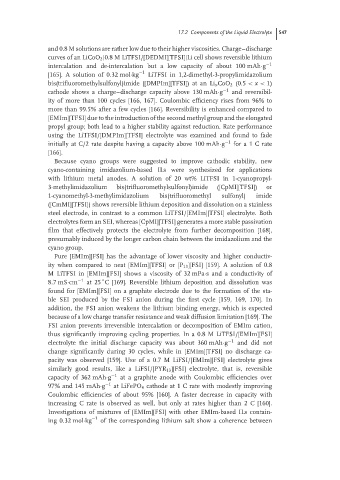Page 573 - Handbook of Battery Materials
P. 573
17.2 Components of the Liquid Electrolyte 547
and 0.8 M solutions are rather low due to their higher viscosities. Charge–discharge
curves of an LiCoO 2 |0.8 M LiTFSI/[DEDMI][TFSI]|Li cell shows reversible lithium
intercalation and de-intercalation but a low capacity of about 100 mAh·g −1
[165]. A solution of 0.32 mol·kg −1 LiTFSI in 1,2-dimethyl-3-propylimidazolium
bis(trifluoromethylsulfonyl)imide ([DMPIm][TFSI]) at an Li x CoO 2 (0.5 < x < 1)
cathode shows a charge–discharge capacity above 130 mAh·g −1 and reversibil-
ity of more than 100 cycles [166, 167]. Coulombic efficiency rises from 96% to
more than 99.5% after a few cycles [166]. Reversibility is enhanced compared to
[EMIm][TFSI] due to the introduction of the second methyl group and the elongated
propyl group; both lead to a higher stability against reduction. Rate performance
using the LiTFSI/[DMPIm][TFSI] electrolyte was examined and found to fade
initially at C/2 rate despite having a capacity above 100 mAh·g −1 for a 1 C rate
[166].
Because cyano groups were suggested to improve cathodic stability, new
cyano-containing imidazolium-based ILs were synthesized for applications
with lithium metal anodes. A solution of 20 wt% LiTFSI in 1-cyanopropyl-
3-methylimidazolium bis(trifluoromethylsulfonyl)imide ([CpMI][TFSI]) or
1-cyanomethyl-3-methylimidazolium bis(trifluoromethyl sulfonyl) imide
([CmMI][TFSI]) shows reversible lithium deposition and dissolution on a stainless
steel electrode, in contrast to a common LiTFSI/[EMIm][TFSI] electrolyte. Both
electrolytes form an SEI, whereas [CpMI][TFSI] generates a more stable passivation
film that effectively protects the electrolyte from further decomposition [168],
presumably induced by the longer carbon chain between the imidazolium and the
cyano group.
Pure [EMIm][FSI] has the advantage of lower viscosity and higher conductiv-
ity when compared to neat [EMIm][TFSI] or [P 13 ][FSI] [159]. A solution of 0.8
M LiTFSI in [EMIm][FSI] shows a viscosity of 32 mPa·s and a conductivity of
◦
8.7mS·cm −1 at 25 C [169]. Reversible lithium deposition and dissolution was
found for [EMIm][FSI] on a graphite electrode due to the formation of the sta-
ble SEI produced by the FSI anion during the first cycle [159, 169, 170]. In
addition, the FSI anion weakens the lithium binding energy, which is expected
because of a low charge transfer resistance and weak diffusion limitation [169]. The
FSI anion prevents irreversible intercalation or decomposition of EMIm cation,
thus significantly improving cycling properties. In a 0.8 M LiTFSI/[EMIm][FSI]
electrolyte the initial discharge capacity was about 360 mAh·g −1 and did not
change significantly during 30 cycles, while in [EMIm][TFSI] no discharge ca-
pacity was observed [159]. Use of a 0.7 M LiFSI/[EMIm][FSI] electrolyte gives
similarly good results, like a LiFSI/[PYR 13 ][FSI] electrolyte, that is, reversible
capacity of 362 mAh·g −1 at a graphite anode with Coulombic efficiencies over
97% and 145 mAh·g −1 at LiFePO 4 cathode at 1 C rate with modestly improving
Coulombic efficiencies of about 95% [160]. A faster decrease in capacity with
increasing C rate is observed as well, but only at rates higher than 2 C [160].
Investigations of mixtures of [EMIm][FSI] with other EMIm-based ILs contain-
−1
ing 0.32 mol·kg of the corresponding lithium salt show a coherence between

